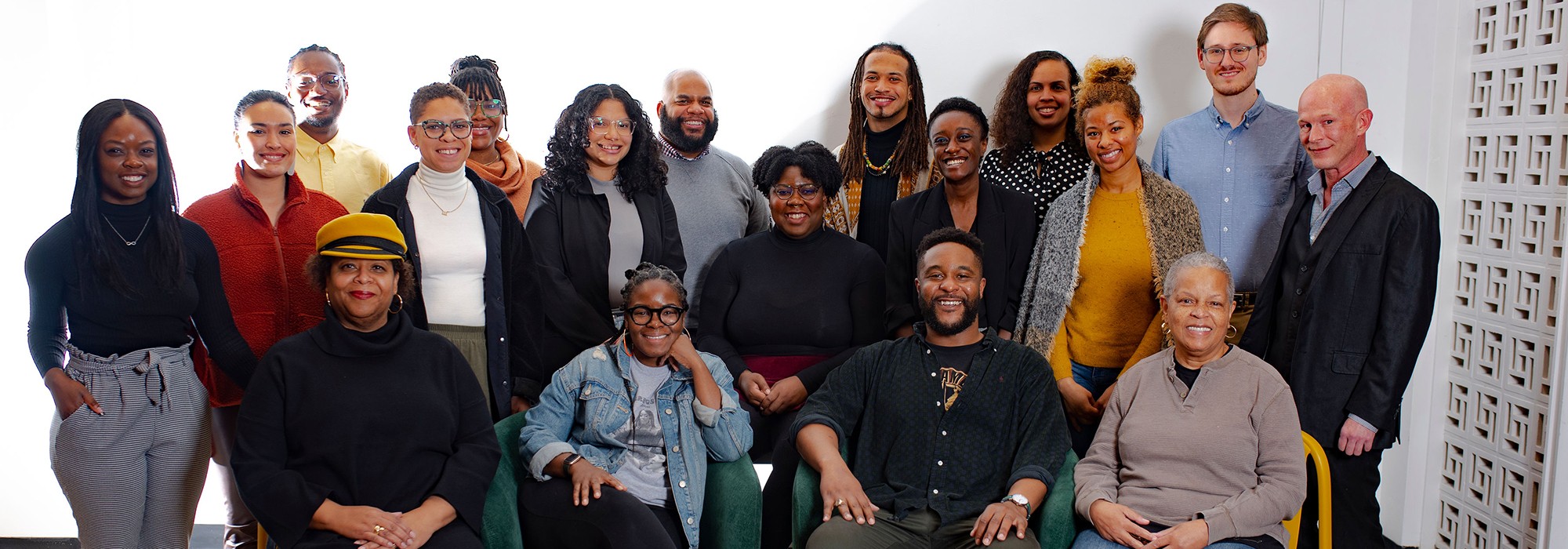It Takes One: ThirdSpace Action Lab
ThirdSpace Action Lab (TSAL) in Cleveland, Ohio, is a grassroots research, strategy, and design cooperative dedicated to prototyping creative place-based solutions to actualize racial equity. Ahead of the launch of TSAL's Chocolate City Cleveland Map (CCCM) and TCLF's upcoming What's Out There Weekend Cleveland, TCLF asked Mordecai Cargill (above, seated second from right), co-founder and creative director of ThirdSpace Action Lab and Third Space Café, and India Pierre-Ingram (above, standing second row third from right), Chocolate City Cleveland Project Manager, about Cleveland's cultural landscapes and the power of urban design to create systemic change.
How would you define a cultural landscape?
We at TSAL understand cultural landscapes as places that have been built and designed by humans in a specific, cultural, political, and historical way. The cultural landscape might also be considered a meaning-making mechanism by which our society’s values are conveyed + reinforced. TSAL’s consulting practice is rooted in a foundational acknowledgement that structural racism is the context for contemporary socioeconomic inequality. Our work with community development practitioners, cultural institutions, and other civic stakeholders typically involves co-designing strategic interventions intended to rectify the ways that the built environment is and has been shaped to reflect the ideologies and narratives of White Supremacy.
And yet we believe that examining the culturally significant sites built and designed by Black folks in our community, reveals the potential of the built environment to showcase joy, liberation, and a more reciprocal connection to nature.
What prompted you to start ThirdSpace Action Lab?
TSAL emerged out of an activist impulse. Our Co-Founders were mobilizing Cleveland’s community economic development network around an awareness-building campaign intended to establish Racial Equity + Inclusion as a unifying framework for neighborhood revitalization. Through this effort the Founders recognized a need for more concrete examples of applied racial Justice practice. TSAL was created to prototype place-based interventions in the patterns of structural inequity + racial exclusion that uniquely impact Black + Latinx communities. However, recognizing that the very nature of consulting makes our experimentation/work inaccessible to the communities most impacted by the problems we’re engaged to tackle, TSAL opened a physical space (now called the ThirdSpace Reading Room) to demonstrate what racial equity + inclusion might FEEL like in the physical realm.
How did your understanding of Cleveland’s urban design, public space, and cultural landscapes change as a result of your work?
TSAL’s consulting practice is best summarized by three buckets: 1. Research + Strategy Design; 2. Community Collaboration (public education + engagement); 3. Space Activation (temporary and semi-permanent; in-person and virtual). Each of the buckets are connected by what we call The Impact Continuum—Constant Awareness Building leading to more thoughtful action. In our Space Activation work, TSAL is attempting to bring our experiments with Racial Justice principles out of the consulting project deliverable + use what we’re learning to create more liberated spaces for Black + Latinx people in Cleveland (and beyond).
As TSAL expanded its work beyond Awareness Building + began to experiment with applied Racial Justice principles, our team gained a greater appreciation for the complex (often subtle, and underestimated) ways in which the built environment reflects our society’s racial logic. The reality of racial inequity is not only present in the data (e.g. social determinants of health); it can be visually perceived in the areas of a city where the concentration of vacant + abandoned buildings is the highest and cultural institutions + recreational amenities are few and far between.
Did the understanding of others change as well? If so how?
TSAL’s work to sustain the local Racial Equity + Inclusion awareness building movement continues. Since our founding in 2018, we’ve been organizing a monthly cadence of workshops + training sessions provided by our close collaborators at the Racial Equity Institute. By the end of 2023, attendance figures will exceed 15,000 individuals—with many participants returning more than once—and we have been encouraged by the shifts in practice we’ve facilitated through applied racial equity experiments with TSAL Clients + Collaborators.
What is the message that you would like to give our readers that may inspire them to make a difference?
TSAL humbly submits a two-part takeaway message: There is always a good reason to celebrate black history. We can and should revisit the legacy of BlackSpaceMakers for inspiration in creating the cultural landscapes of the future.
TSAL’s observance of Juneteenth this year was the occasion for launching our Chocolate City Cleveland Map (CCCM). CCCM is a museum in the palm of your hands—a multimedia, digital tour of Cleveland’s E. 105th Street Corridor—that pays tribute to the people + places that uniquely contributed to Black History + Culture + Hustle through the radical lens of Black Joy + Imagination. The CCCM is an attempt to honor the legacy of local black leadership + to memorialize the uniquely black spaces that shaped the cultural landscape of Cleveland’s historically black neighborhoods. Our greatest aspirations for this project are to reframe the discourse on black neighborhoods + reinvigorate conversations about cultural preservation—emphasizing the memories of “The Good Ole Days” as a starting point for a new collective vision for the future that considers the presence of black people as an asset (rather than liability) to the neighborhood identity.



